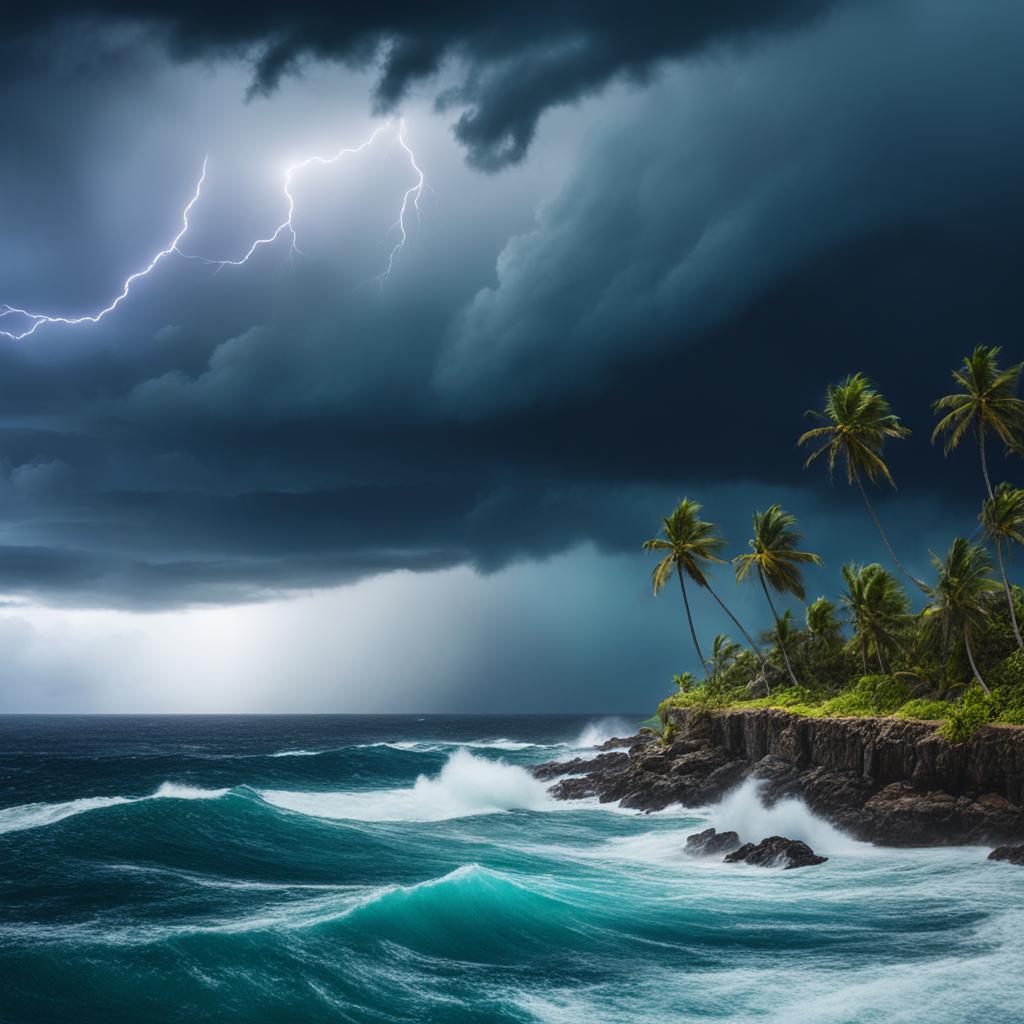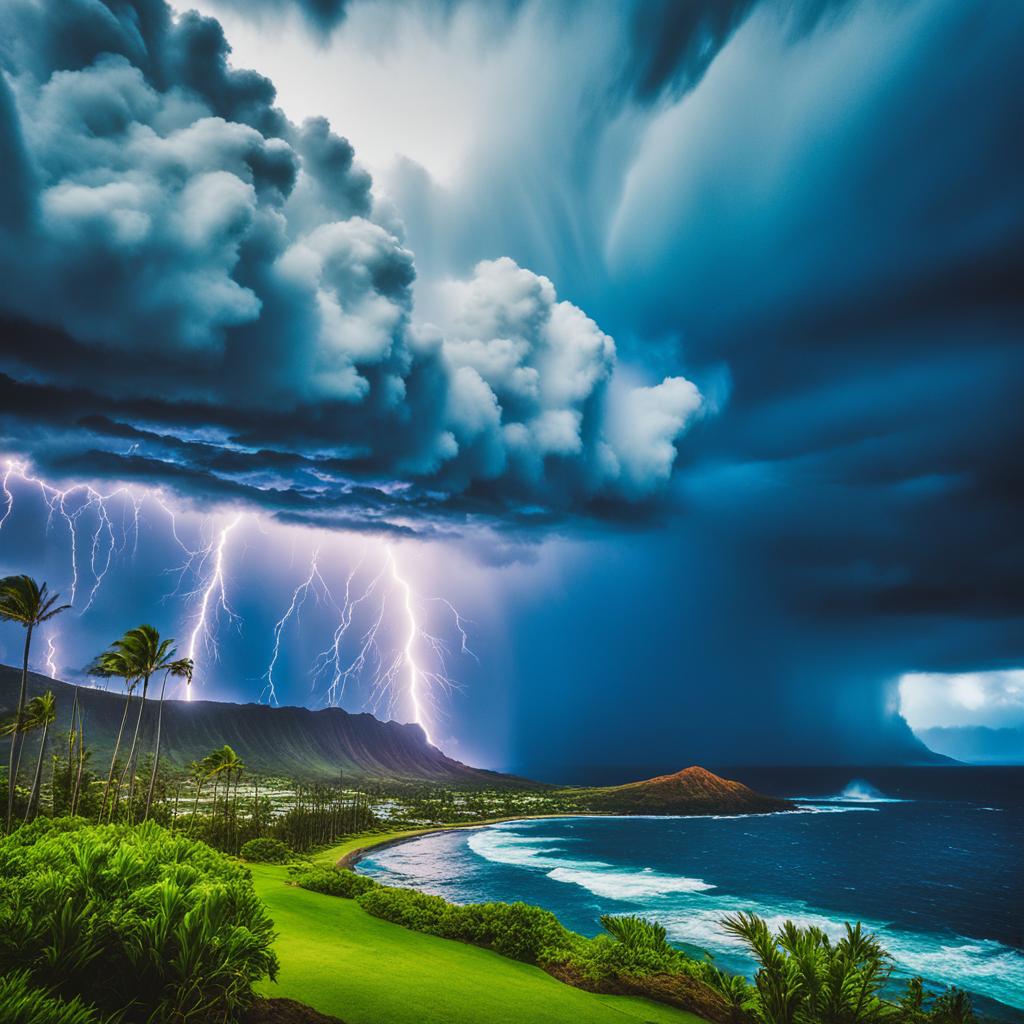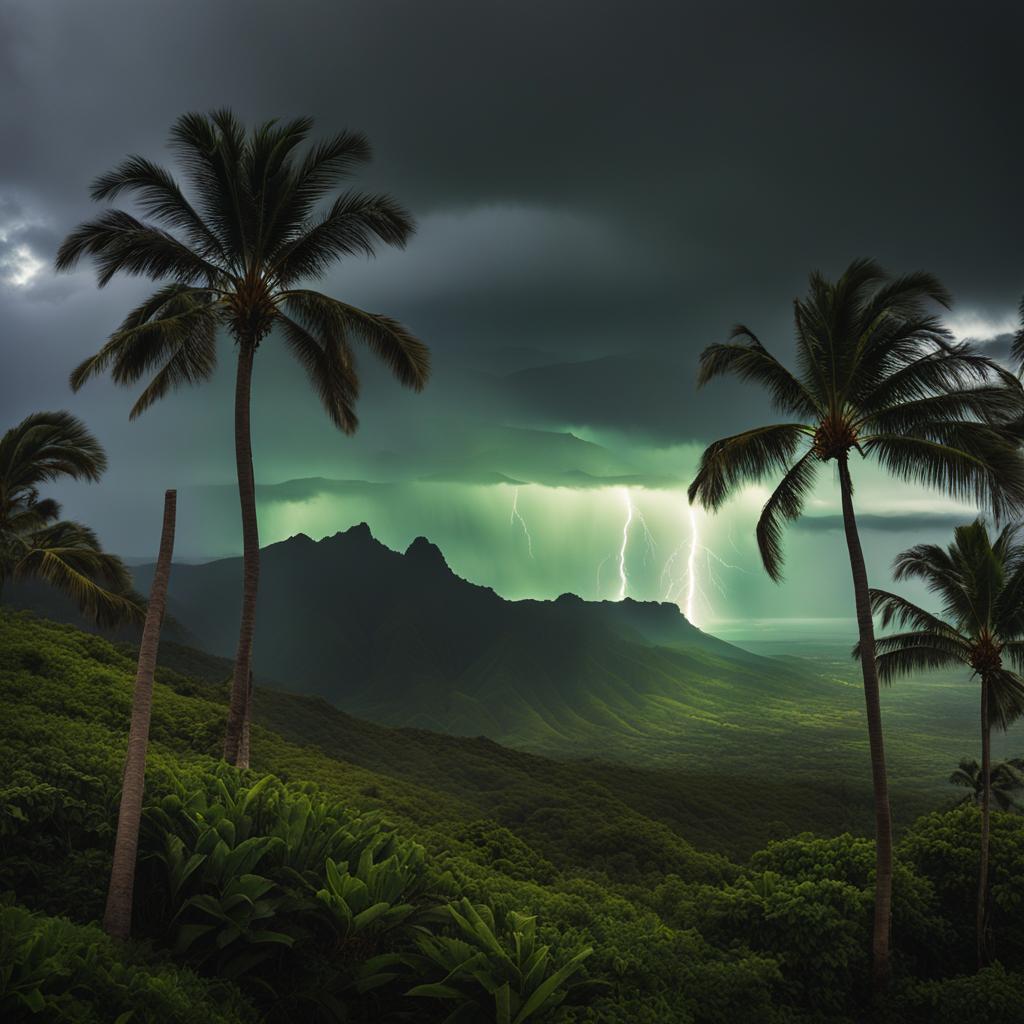When you think of Hawaii, you might imagine pristine beaches, lush landscapes, and tranquil paradise. But have you ever wondered if thunder and lightning storms are a part of this tropical paradise’s weather patterns? Contrary to popular belief, thunderstorms do occur in Hawaii, although they are relatively rare. Let’s explore the fascinating world of thunder and lightning in the Aloha State and uncover the secrets of its unique weather patterns.
When and Where Do Thunderstorms Occur in Hawaii?

Thunderstorms in Hawaii are most active during the winter months, from November to March. This is when the islands experience cooler temperatures and higher levels of moisture, creating the perfect conditions for thunderstorm formation.
Thunderstorms in Hawaii are most frequently observed over the mountainous regions, particularly on the Big Island. The peaks of Mauna Kea and Mauna Loa, both exceeding 13,000 feet in elevation, experience thunderstorms more often than other parts of the state.
Thunderstorms also occur along the coasts, particularly during the summer months. The warm ocean waters and convergence of trade winds can lead to the formation of thunderstorms near the shorelines.
It’s important to note that thunderstorms in Hawaii are generally less severe and frequent compared to other parts of the world, but they can still bring heavy rainfall, gusty winds, and occasional lightning.
| Month | Average Number of Thunderstorm Days |
|---|---|
| November | 4 |
| December | 5 |
| January | 5 |
| February | 5 |
| March | 4 |
These thunderstorms contribute to the lush green landscapes and vibrant ecosystems that make Hawaii such a unique and beautiful place.
What Causes Thunderstorms in Hawaii?

Thunderstorms in Hawaii are a fascinating natural phenomenon that occur due to specific weather patterns and geographical features. Understanding the causes behind these thunderstorms can help us appreciate the unique conditions that contribute to their formation.
One of the main factors that cause thunderstorms in Hawaii is the warm, moist air. The ocean surrounding the islands provides a constant supply of moisture to the atmosphere. As the sun heats the surface of the ocean, the air above it becomes warm and rises, creating an upward current of air. This upward movement leads to the formation of cumulus clouds, which can eventually develop into thunderstorms.
Another contributing factor is the temperature differences caused by the diverse topography of the islands. Hawaii’s varied landscape, with its mountains and valleys, can trigger rapid upward movement of air known as convection. This convection process further enhances the development of thunderstorms by creating a dynamic environment for cloud formation and rainfall.
Frontal boundaries, which occur at the meeting points between different air masses, also play a role in thunderstorm formation. When a cold front moves into the area, it creates instability in the atmosphere, leading to the initiation of thunderstorm activity. Similarly, when a warm front moves into Hawaii, it lifts the warm, moist air, creating conditions favorable for thunderstorm formation.
The unique geographical features of the islands, combined with warm, moist air, temperature differences, and frontal boundaries, result in the occurrence of thunderstorms in Hawaii. These natural phenomena contribute to the dynamic and ever-changing weather patterns experienced throughout the islands.
| Causes of Thunderstorms in Hawaii | Contributing Factors |
|---|---|
| Warm, moist air | Ocean temperatures |
| Temperature differences | Topography of the islands |
| Frontal boundaries | Meeting points of air masses |
Characteristics of Thunderstorms in Hawaii

Thunderstorms in Hawaii exhibit distinct characteristics that set them apart from thunderstorms in other parts of the world. While they may be less severe and frequent, it’s important to understand their unique features to stay safe and prepared.
1. Heavy Rain: Thunderstorms in Hawaii bring heavy rainfall, often resulting in torrential downpours. These intense rain showers can lead to localized flooding in low-lying areas, posing a threat to residents and infrastructure.
2. Lightning: Lightning is a powerful natural phenomenon that occurs during thunderstorms. In Hawaii, thunderstorms can produce lightning strikes when electrical charges build up in the atmosphere, creating awe-inspiring displays of nature’s electric energy.
3. Gusty Winds: While not reaching the intensity of hurricanes, thunderstorms in Hawaii can generate strong and gusty winds. These winds can cause branches to snap, debris to become airborne, and pose a risk to outdoor activities.
4. Occasional Hail: Though less common, thunderstorms in Hawaii can produce hail. Hailstones are formed when strong updrafts in the thunderstorm carry raindrops to higher altitudes where they freeze into ice pellets. Hail can vary in size and may cause damage to crops, vehicles, and buildings in affected areas.
To gain a better understanding of the characteristics and behavior of thunderstorms in Hawaii, it’s essential to monitor local weather forecasts and stay informed about any thunderstorm warnings or watches issued by the National Weather Service – Honolulu Forecast Office.
Staying Safe in a Hawaiian Thunderstorm
When a thunderstorm approaches in Hawaii, it is crucial to prioritize your safety. Seek shelter indoors immediately to protect yourself from potential hazards. Find a sturdy building, such as a house or commercial establishment, and stay inside until the storm passes. Avoid seeking shelter under trees or near bodies of water, as these areas can be particularly dangerous during a thunderstorm.
Lightning is a major concern during thunderstorms, and it’s essential to take precautions to reduce the risk of getting struck. Avoid open areas, hilltops, and high ground as they are more prone to lightning strikes. If you find yourself caught in an open space with no immediate shelter, crouch down low with your feet together, minimize contact with the ground, and make yourself as small a target as possible.
It’s also important to stay away from tall objects such as poles, trees, and metal structures that can attract lightning. These objects increase the chances of a lightning strike and pose a significant risk to your safety. Additionally, if you are driving in a thunderstorm, exercise caution due to heavy rain and reduced visibility. Be aware of road conditions and adjust your speed accordingly to ensure a safe journey.
Remember, Hawaiian thunderstorms may be less severe compared to other regions, but they still require vigilance and adherence to safety precautions. By seeking shelter, avoiding open areas, and staying away from tall objects, you can protect yourself and minimize the risks associated with thunderstorms in Hawaii.
FAQ
Q: Does Hawaii get thunder and lightning?
A: Yes, thunderstorms are rare in Hawaii, but they do occur a few times a year. Thunderstorms in Hawaii are most active during the winter months, from November to March.
Q: When and where do thunderstorms occur in Hawaii?
A: Thunderstorms in Hawaii are most active during the winter months, from November to March. They are most frequently observed over the mountainous regions, particularly on the Big Island. Coastal areas can also experience thunderstorms, especially during the summer months.
Q: What causes thunderstorms in Hawaii?
A: The main ingredients for thunderstorm formation in Hawaii are warm, moist air, temperature differences, and frontal boundaries. The warm ocean temperatures provide a constant supply of moisture to the atmosphere, while temperature differences caused by the diverse topography of the islands can trigger convection. Frontal boundaries can also contribute to thunderstorm formation.
Q: What are the characteristics of thunderstorms in Hawaii?
A: Thunderstorms in Hawaii are characterized by heavy rain, lightning, gusty winds, and occasionally hail. They can bring torrential downpours, leading to localized flooding in some areas. While generally less severe and frequent compared to other parts of the world, thunderstorms in Hawaii should still be taken seriously.
Q: How can I stay safe in a Hawaiian thunderstorm?
A: When a thunderstorm approaches in Hawaii, it is crucial to seek shelter indoors. Avoid seeking shelter under trees or near bodies of water. Take precautions to reduce the risk of getting struck by lightning, such as avoiding open areas, hilltops, and high ground. It’s also important to drive cautiously and be aware of road conditions during a thunderstorm.
